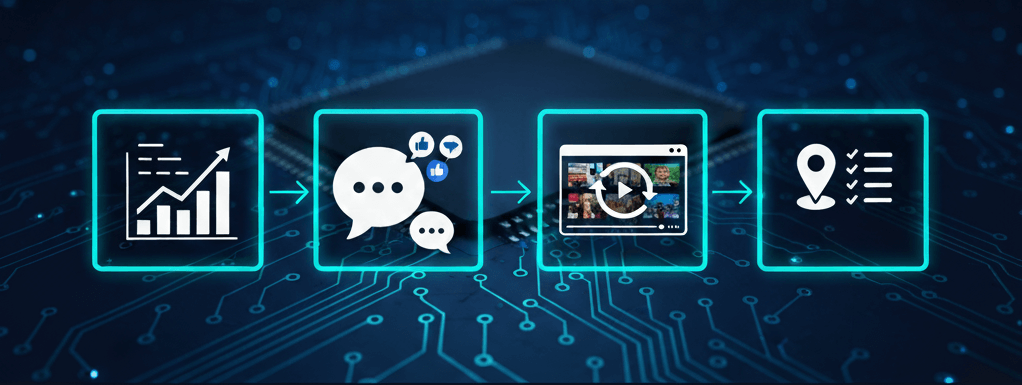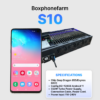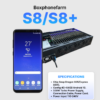Increasing YouTube Views isn’t a matter of luck: it’s the biggest challenge for any creator trying to stand out among millions of new videos every day. You invest hours recording, editing, and polishing content, only to see it stagnate with few views while generic tips no longer work in YouTube’s sophisticated ecosystem.
The reality is that there is no magic trick, but a system based on understanding and satisfying both the viewer and the algorithm, one of the most advanced AIs in the world. At GenFarmer, as experts in technology and automation applied to digital marketing, we break down 18 organic strategies designed to align your goals with YouTube’s, so you can stop guessing and start applying a methodology that truly drives your channel’s growth.
Part 1: The Strategic Foundation (Before Recording)
Views don’t start when you upload the video. They start with a bulletproof content strategy.

1. Conduct Semantic Keyword Research
The first step is to understand the user’s search intent, not just the words they type. This is known as semantic search. This strategy works because YouTube, as the world’s second-largest search engine, prioritizes videos that comprehensively answer a user’s query. For example, instead of targeting “dogs,” it’s more effective to target “why does my dog eat grass and vomit?”.
To do this effectively:
- Use the YouTube autocomplete bar. Type your topic and see what it suggests.
- Analyze the “People also ask” section on Google for your keyword.
- Use tools (even free ones) to find related questions and topics, not just high-competition keywords.
2. Adopt the “Hero, Hub, Help” Content Model
This is a Google model for structuring your content calendar to increase views sustainably. It’s divided into three content types:
- “Help” Content: Evergreen videos that answer common questions. They are the foundation of your channel and attract consistent search views. (e.g., “How to change a tire”).
- “Hub” Content: Regular, episodic content for your community and subscribers. (e.g., Your weekly series, vlogs, analysis).
- “Hero” Content: Big viral events designed to attract a massive audience. (e.g., A documentary, a major collaboration).
The reason this model is so effective is that it diversifies your traffic sources (search, subscribers, virality) and builds a loyal audience, not just single-video viewers.
3. Thoroughly Analyze Your Competition (and their Comments)
You must watch the top 5-10 ranking videos for your target keyword and analyze them deeply. Success leaves clues, and you need to understand why the algorithm chose those videos.
During your analysis, look at:
- Structure: How do they start the video? How quickly do they get to the point?
- Production: Do they use B-roll? Motion graphics?
- Metrics: How long are they? (Often, longer, high-retention videos win).
- Comments: This is the gold mine! Read the top comments. What questions do viewers still have? What parts did they love? Your video must address those gaps.
4. Create “Reference Content” (The Definitive Video)
Don’t just make “another” video on a topic. Your goal must be to create the last video someone will ever need to watch on that topic. If the competition makes “5 tips,” you make “The Complete Guide with 15 Tips (With Examples).” This works because YouTube’s algorithm rewards “ultimate query satisfaction.” If a user watches your video and doesn’t need to search again on the topic, you’ve won, skyrocketing your watch time and positioning you as an authority.
Part 2: Optimizing the “Package” (The Art of Getting the Click)
You can have the best video in the world, but if no one clicks on it, it doesn’t exist. The “package” (thumbnail, title, description) is your first battle.

5. Master High-CTR Thumbnails
CTR (Click-Through Rate) is the percentage of people who see your thumbnail in their recommendations and click it. It is, possibly, the most important metric for increasing new views. A high CTR tells the algorithm, “When we show this to people, they are interested.” The algorithm will then show it to more and more people.
To create effective thumbnails:
- Clarity: It must be understood in one second, even on a mobile phone.
- Emotion: Show a face with a clear emotion (surprise, happiness, intrigue).
- Contrast: Use bright, contrasting colors.
- Minimal Text: 3-4 words maximum. The text should complement the title, not repeat it.
6. Write Magnetic Titles (Not Just SEO-Optimized)
A great title balances two things: the keyword (for search) and curiosity (for the click). It combines search intent (the user finds what they’re looking for) with an emotional reward (intrigue, specific value).
- SEO Title: “How to Increase Views on YouTube (2025 Guide)”
- Magnetic Title: “18 Tactics to Increase Views (Tactic #7 Changed my Channel)”
7. The First 15 Seconds: The “Hook”
Your CTR gets you the click, but the first 15 seconds determine your Audience Retention. If you lose the viewer here, your Average View Duration (AVD) plummets, and the algorithm buries your video.
In this time, you must do three things:
- Confirm the promise of the title/thumbnail.
- Build intrigue about what’s to come.
- Demonstrate immediate value.
8. Optimize the Description like a Mini-Blog
Don’t leave the description empty. The algorithm reads it to understand the context. This helps semantic SEO, as YouTube better understands the different facets of your video, allowing it to recommend it for related queries that might not even be in your title.
A good description should:
- Include 2-3 paragraphs summarizing the video, using your main keyword and 2-3 secondary ones.
- Include links to your other content (to increase session time).
- Add Timestamps. (See tactic #17).
9. Use Tags Strategically
Tags are less important than they used to be, but they aren’t useless. They help YouTube contextualize your video, especially if your channel is new, acting as contextualization insurance.
Your tag strategy should include:
- Specific Tag: “how to increase views on youtube”
- Broad Tag: “youtube seo”, “grow on youtube”
- Brand Tag: “genfarmer”
- Common Misspelling Tag: “how to increase views” (to capture typos).
Part 3: Mastering the Algorithm (Retention and Session Time)
You got the click. Now, the job is to keep the viewer glued to the screen. The algorithm rewards Average View Duration (AVD) and Session Time above all else.

10. Edit for Average View Duration (AVD)
AVD is the average percentage of your video that people watch. 50-60% is excellent. This is the most direct satisfaction metric for the algorithm; a high AVD means the content is valuable. If your 10-minute video is only watched for 2 minutes (20% AVD), the algorithm will consider it low quality and stop recommending it.
To improve your AVD, you must edit ruthlessly:
- Jump Cuts: Remove every breath, every “um,” every unnecessary pause.
- Pattern Interrupt: Change the camera angle, add a graphic, a meme, or a B-roll clip every 10-20 seconds.
- Open Loops: “Stay until the end, where I’ll reveal the #1 mistake…”
11. Encourage Quality Interaction (Not Generic)
Asking for interaction generically is weak. Instead of “Comment below,” try “Comment below which of these 18 tactics you will try first.”
Comments, “likes,” and “shares” are engagement signals. They tell YouTube that your video is creating a community, not just consuming bandwidth. Reply to comments in the first hour to double this signal.
12. Use End Screens and Cards (The Session Loop)
Session Time is the total time a user spends on YouTube after starting with your video. It’s the golden metric. If at the end of your video, the user leaves YouTube, you’ve ended their session (bad!). If they click your end screen to watch another of your videos, you’ve extended their session (excellent!).
To do this well, don’t wait until the very end. In the last 20 seconds, stop talking and actively guide the viewer (with your voice and visually) to click on the next relevant video appearing on the end screen.
13. Create Optimized Playlists
Playlists are the most underrated tool for increasing views and session time. They are the easiest way to get someone to watch several of your videos in a row, thanks to the “Autoplay” feature.
Implement this by creating series (e.g., “YouTube SEO Course,” “Weekly Analysis”), naming the playlist with keywords (e.g., “Tips to Increase Views”), and linking to these playlists in your descriptions and cards.
14. Pin a Strategic Comment (Pinned Comment)
Pin your own comment at the top. People who read comments (many!) will see it first. It’s a free second “call to action” (CTA).
You can use it to:
- Ask a follow-up question to generate more interaction.
- Add a correction or update (this builds trust).
- Link to a playlist or your product.
Part 4: Promotion and Scaling (Organic Expansion)
Your video is optimized and valuable. Now, give it the initial push.

15. Publish at the Right Time (For the Initial Boost)
Publish your video when your main audience is online. The first hour (the “Golden Hour”) is critical. If your video gets many views and interactions quickly from your subscribers, the algorithm will test it with a broader audience (recommendations).
You can find this information in YouTube Studio > Analytics > Audience. There’s a graph that tells you exactly when your viewers are online. Publish 1-2 hours before that peak.
16. Cross-Promotion on Short Formats (TikTok, Shorts, Reels)
Take a 30-60 second high-impact clip from your long video and post it as a YouTube Short, an Instagram Reel, or on TikTok. This allows you to use these massive discovery platforms as a “trailer” for your main content; instead of competing, they complement each other.
The key is not to give the full answer in the short clip. Build intrigue and end with a clear CTA: “The full analysis and the other 17 tactics are in the video on my channel. Link in bio/comments.”
17. Add Video Chapters (Timestamps)
Breaking down your video into sections (e.g., 00:00 Intro, 01:30 Tactic 1, 03:45 Tactic 2…) has a dual benefit. First, it improves the user experience (UX), allowing them to jump to what interests them. This can *increase* the total AVD if you prevent them from leaving out of impatience. Second, Google now indexes YouTube chapters. Your video can appear in Google search with “rich snippets” for specific sections, giving you more entry points.
18. Use the Premieres Function
Schedule your video as a “Premiere.” This creates a public waiting page and allows you to live chat with your audience as they watch the video for the first time. This turns passive viewing into a community event, generating a massive peak of interaction (live comments) and watch time in the “Golden Hour,” sending extremely positive algorithm signals from the first minute.
Conclusion: From Strategy to Infrastructure
As we have seen, increasing views on YouTube organically is not a mystery; it’s a science. It requires a disciplined system to understand user intent (semantic research), capture their attention (CTR and thumbnails), and hold it (AVD and Session Time). These 18 tactics are the foundation for aligning your content with the algorithm’s goals.
Implementing this strategy is a full-time job, but scaling it to multiple channels and 24/7 operations is an infrastructure challenge. That’s where strategy meets technology. At GenFarmer, we provide the hardware and cloud solutions to industrialize your digital marketing operations. While you focus on content, we provide the technological foundation with our Cloud Phone for secure management, Box Phone Farm for large-scale automation, and Routers and MiniPCs for robust network stability. Stop fighting the algorithm and start building a system that works for it. Explore our solutions and take your YouTube strategy from theory to industrialization.











